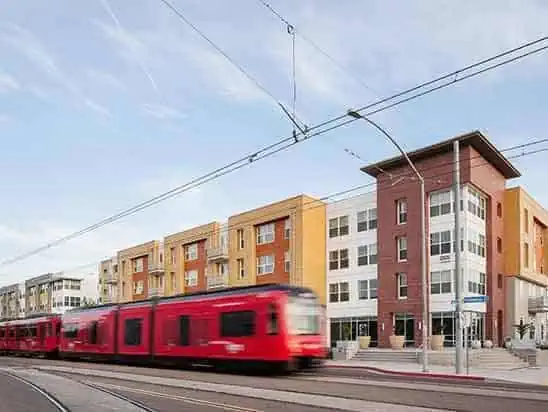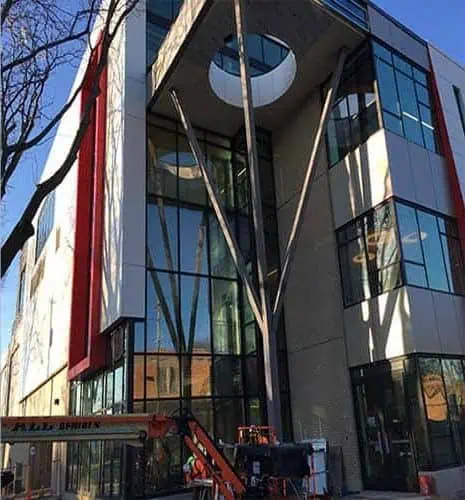


California’s 2021 and 2022 budgets provide $500 million to the Department of Toxic Substances Control to support community revitalization. The funds are available over four years to accelerate the investigation and cleanup of contaminated properties in environmental justice communities. This funding is referred to as the Cleanup in Vulnerable Communities Initiative. A portion of this funding is for establishing the Equitable Community Revitalization Grant (ECRG)—a grant program to incentivize cleanup and investment in disadvantaged areas of California.
Equitable Community Revitalization Grant – Learn more about the program and how to use this funding to advance your communities brownfields and remediation projects.
Brownfields and Voluntary Remediation – Brownfield and voluntary remediation projects protect human health and the environment while restoring beneficial use to properties. SCS Engineers is a pioneer in supporting the public-private partnerships for these types of redevelopment. SCS helped redevelop environmentally impaired real estate more than 25 years before the term Brownfield was coined. Learn more about the possibilities for your community and how to select a brownfields remediation professional for timely and compliant delivery of the benefits.
ECRG Flyer – Provides the basics on this new and important funding along with a timetable.
The main thoroughfare in Madison, Wisconsin, leading to the state capitol, is going through a major renaissance. Once an idle brownfield, and before that an active industrial-commercial area, the entire block has now been converted to residential, commercial, and office spaces, as well as a youth art center. After extensive due diligence to assess, then successfully remediate significant adverse environmental conditions from past uses, the property’s new mixed-use buildings are open for occupancy. The community art center opens in 2021.
The block formerly housed a dairy operation, gas station, auto maintenance shops, a print shop, and a dry cleaner. These past uses and the historic fill placed on the property resulted in chlorinated solvents, petroleum, polycyclic aromatic hydrocarbons (PAHs), and heavy metal contamination.
Remediating and mitigating environmental contamination and redeveloping brownfields like this one into vibrant, revenue-generating community assets takes pooled expertise from multiple disciplines, including hydrogeology and environmental engineering.
While these projects can provide high value for communities long into the future, they are complex and require large investments up front, explains Ray Tierney, an SCS vice president. Having a team that gets a full picture of the property’s environmental condition, knows regulators’ expectations, and can identify technically sound, cost-effective remediation and mitigation approaches can translate to substantial money savings.
In this case, a solid knowledge base and vetting key details resulted in seven-digit figure savings and facilitated prized redevelopments.
“We identified the amount of soil and groundwater contamination, evaluated strategies to best address the issues, and came up with a cost estimate for remediation. Based on the estimate, along with documentation validating the scientific rationale for our recommendations, the seller reduced their price to account for the legacy environmental liabilities which the purchaser agreed to accept and address as part of the property’s redevelopment.”
SCS Engineers assessed for contamination; oversaw the management of contaminated soil and groundwater during construction according to the materials management plan; supported the client in securing grants, permits and documented compliance with the approved planning documents.
For this project, as is often true in historic urban areas, the greatest expense was dealing with widespread contamination found in the historic fill soils and with groundwater issues.
“Our client is obligated to handle contaminated materials properly. We plan and permit the proper procedures, work with contractors to facilitate the work, documenting that procedures and plans are followed while making sure they only invest what is necessary to be judicious in protecting the environment and public health,” says the SCS Project Manager and Geologist Dr. Betty Socha.
During construction, Socha’s team was onsite to assist contractors in complying with environmental plans and permits, documenting that activities were completed safely and in compliance with Wisconsin Department of Natural Resources (WDNR) expectations. The team oversaw soil removal and management during site demolition and construction of the foundation, including piles and a structural slab. This support system reduces the geotechnical requirement of the underlying soils to reuse more onsite soil safely. But knowing what soil is acceptable and orchestrating the separation of contaminated and non-contaminated materials takes specialized expertise and skill.
“During construction, we evaluate soil conditions, so contaminated soil is safely disposed of at a landfill. But landfilling large volumes of soil is a considerable expense, so it’s important to determine what is safe to be segregated as clean soils for reuse elsewhere. Knowing how to do this efficiently will minimize disposal costs and maximize the use of valued resources,” Socha says.
Getting a handle on groundwater conditions and identifying the best management strategy requires equal attention.
“This property sits on a strip of land (an Isthmus) between two large and prized lakes, with a shallow water table. We thoroughly assessed the groundwater (aka, hydrogeologic) site conditions and managed groundwater generated during construction and dewatering activities,” says Tierney.
“We documented the extent of contamination, and the WDNR confirmed our evaluation that no additional remedial groundwater treatment systems were needed. We could show the contamination was contained enough to pose no risk to municipal wells, private wells, surface water, or other sensitive environments. However, the client still needed a permit to dispose of the contaminated groundwater generated during dewatering for construction of the building foundation and underground utilities,” says Tierney.
Major brownfield redevelopment projects are involved with multistep processes. They begin with a Phase I Environmental Assessment entailing an inspection of the property and a historical review.
That’s where SCS initially identifies potential or existing environmental liabilities from contamination. Then the team confirms the presence of multiple soil and groundwater contaminants through a Phase II Assessment, involving collecting and analyzing soil and groundwater samples.
Next comes a site investigation, a robust testing program to see exactly what is going on. This is where the team further defines contamination, locations, how far it spread, and concentrations. That information lays the groundwork for developing the remedial action plan to file with the WDNR. The team then works with the redevelopment contractors to seamlessly and concurrently manage both the property’s remediation and the buildings’ construction.
In Madison, Socha, Tierney, and their team also helped the developer apply for and win a $500,000 brownfield grant from the Wisconsin Economic Development Corporation, a practice that is as much an art as a science. Additional public support for the project was also received through tax incremental financing (TIF) and the Wisconsin Housing and Economic Development Authority (WHEDA) tax credits for low‐income housing.
“We merge our technical backgrounds to show the land has the potential to be turned into a strong asset that addresses the legacy environmental contamination, promotes public health, and delivers a high-value property that pays taxes and supports important city services,” says Tierney.

It takes technical horsepower to show regulators just how you are addressing contamination. You need to show the economic development group awarding the grant that the project will create well-paid jobs and tax revenue. Equally important, it must be shown that the redevelopment helps address a community need for affordable workforce housing and additional market-based housing,” Tierney says.
Tenants have already moved into the two 11-story mixed-use buildings. In addition, The Madison Youth Arts Center (MYAC) is slated to open in early summer, with a grand opening ceremony this fall. The MYAC includes classrooms, offices, rehearsal spaces, and a 300-seat auditorium.
The final project showcases the heartbeat of this popular downtown space situated between two large lakes, with features such as a rooftop terrace, plazas with seating and green space, and soon to come are 3D urban art installations and murals that tell the story of this long-lived community.
“The redevelopment of brownfields and the creation of projects like the Lyric and the Arden align with the City of Madison’s Performance Excellence Framework Vision of Our Madison – Inclusive, Innovate, and Thriving. These types of redevelopment projects help the City act as a responsible steward of our natural, economic, and fiscal resources. While making efficient use of land and cleaning up brownfields, the City is able to provide workforce housing, job opportunities, and cultural venues, all while enhancing the City’s tax base,” says Dan Rolfs, the Community Development Project Manager for the City of Madison’s Office of Real Estate Services – Economic Development Division.
It takes a village, or in this case – a City, to revitalize an urban brownfield!
Brownfields Resources to Organize, Educate, and Implement Plans in Your Community
FREE LIVE WEBINAR & Q/A
If you can solve their many challenges, landfills often are perfect sites for a myriad of uses. Landfill redevelopment can be smart growth, taking advantage of existing infrastructure and nearby populations to provide infill opportunities for commercial, industrial, residential, and recreational development, sometimes with an opportunity for alternative energy such as solar power. And more active use of a closed landfill site makes post-closure care more robust as compared with quarterly inspections.
Register for SCS Engineers’ February webinar to learn more about the environmental and regulatory strategies to assess and redevelop closed landfills for reuse and, by doing so, set realistic goals toward cost-effective and sustainable economic development. SCS webinars are non-commercial, and your registration information is confidential.
You will receive an email from Zoom containing a private link to attend; the link is reserved for only you. If you would like to share information about this webinar, please share this blog.
We hope you will join us to learn about evaluating the feasibility of converting closed landfills into self-sustaining or revenue-generating assets.
The Los Angeles County Board of Supervisors designated Alpine Village in Torrance, a Historic Landmark. The parking lot is a former landfill, and in the early ’70s, SCS Engineers designed building protection/sub-floor ventilation systems for several on-site structures. Once completed, SCS entered into contracts to monitor, maintain, prepare, and submit regulatory reports that the firm still performs well to this day.
“As we celebrate our 50th Anniversary, Alpine Village is an example of one of SCS’s oldest and longest continuously running projects,” said President and CEO Jim Walsh. We’re proud that we provide valuable environmental services to businesses and communities.”
Dave Ross, Senior VP (retired), said, “This certainly underscores SCS’s longevity and sustained superior client service. I can recall the elation when we won the first LFG [landfill gas] monitoring job there…I completed one of the earliest rounds of [air] sampling on the roof of the main building.”
Learn more about SCS Engineers and the award-winning environmental services this employee-owned firm provides.